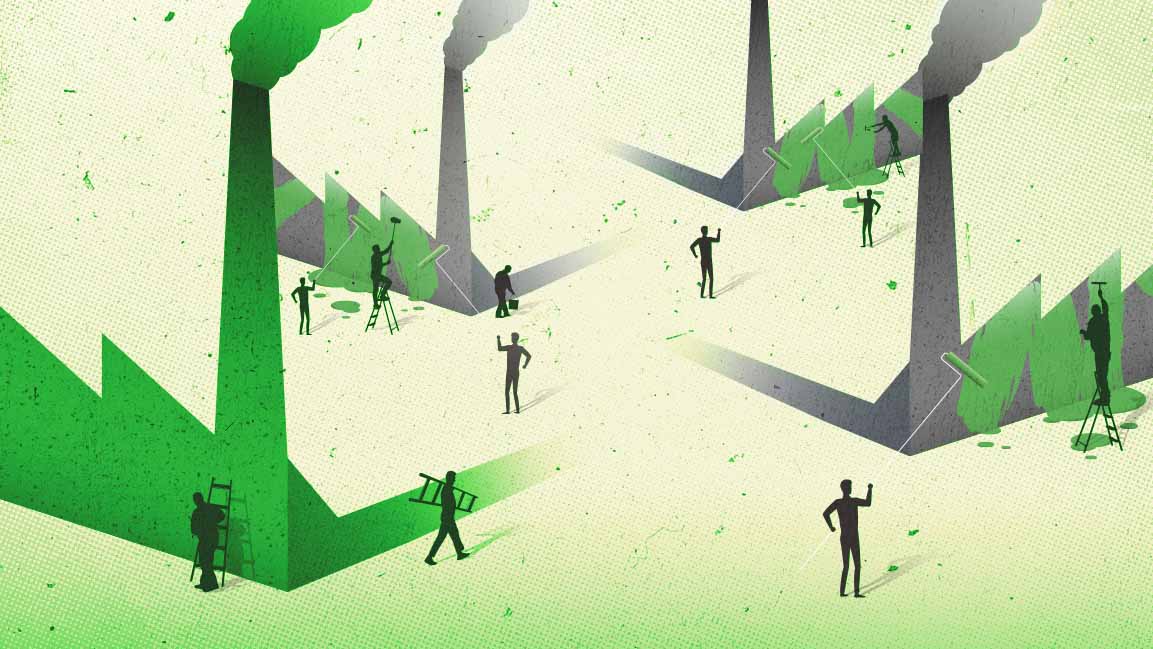- | 8:00 am
Green jobs are hiring: Here’s how to get the skills you need
Every job is about to become a climate job, whether you’re an architect or a project manager. People with green skills are far more likely to be hired faster.

There are a little more than seven years left for the world to cut carbon emissions in half to avoid the worst impacts of climate change—and only a few decades to decarbonize the entire economy, from energy to agriculture. The massive scale of the transformation means that essentially every job is about to become a climate job, whether you’re an architect or a project manager.
The demand for “green” skills is starting to quickly outpace available talent: A recent LinkedIn report found that the number of job postings requiring at least one sustainability-related skill grew 22.4% between 2022 and 2023, while only one in eight workers currently has those skills. People who have green skills are more likely to be hired faster.
The fastest-growing green skill in the U.S., according to LinkedIn’s data on its member profiles, is climate accounting, which grew 240% year-over-year. (Related areas like carbon credits, carbon emissions, and energy audits aren’t far behind on the list.) That’s not surprising, as companies scramble to figure out how to measure and report their emissions and make credible plans to reduce them. Even if you’re not planning to change jobs right now, it’s increasingly likely that you’ll need to pick up new climate skills for your existing job. Here’s where to start.
TAKE A CLASS
Terra.do, one online platform, was designed to help people quickly shift into climate work or gain specific climate-related skills for their current roles. “It started out of my own personal frustration trying to make the transition,” says Anshuman Bapna, a tech entrepreneur who previously worked at companies like Google. He saw a lack of structured tools to help, at a time when the scale of the challenge means that everyone needs to understand the basics of climate science and potential solutions.
“We’re talking about a transformation of the global economy that’s unlike anything we’ve ever attempted in history,” he says. “We’re talking about changing energy, agriculture, transportation, manufacturing, and finance, and not just in one country, but across the world. And not in 100 years, but 10 or 20 years. That’s about a third of the world’s GDP.” Right now, he says, depending on how you do the math, only around 2 million people are working on climate change; he argues that to tackle the problem, hundreds of millions of people will need to work on it.
Terra.do’s platform offers both a broad climate “bootcamp” along with individual classes on topics like carbon accounting and the fundamentals of ESG. Soon, Bapna says, the site plans to add more resources for non-office jobs, like solar installation. Climatebase, another site that shares climate-related positions, offers a 12-week fellowship to help people transition to climate jobs. Other sites, including LinkedIn, offer introductory courses to sustainable business. Several universities also offer related classes either online or in person. If you happen to be in Boston, for example, you can take an extension class at Harvard focused on how to calculate, manage, and reduce greenhouse gas emissions.
MIT offers an online class in lifecycle assessment, a way to systematically calculate the potential environmental impact of a product, from its materials manufacturing, to its use, to how it’s likely to be thrown away. The students might not ever have to create an LCA themselves, but the class can help them understand how it works. It’s likely this skill will become even more important as people have to make an increasing number of climate-related decisions in their jobs, whether they’re designers or working with suppliers, or in a marketing department explaining a product’s impact.
“There might be someone else in the company or a consultant who’s doing the actual calculations behind the LCA, but it’s really important for those people who are using it in their decisions to understand how those numbers were obtained and the assumptions around them,” says Jeremy Gregory, the executive director of the MIT Climate and Sustainability Consortium, a program that works with companies to help them find new ways to shrink emissions.
The class launched after demand from companies. “We hear from so many of them about what we often refer to as the sustainability skills gap,” Gregory says. “They really need to hire people with sustainability skills. They can’t find enough in the marketplace. And so as a consequence, they’re thinking a lot about how much training do they do internally. This LCA course is just one thing we’re working on with them.”
Some classes are targeted at specific groups. The University of Michigan’s Erb Institute, for example, is launching a new class next week designed for corporate board members that looks at sustainability broadly, from what ESG means to how companies should disclose information. Boards “need to be in a position to ask the right questions, at the right time, to make sure that management has got the company on the right track,” says Tom Lyon, the professor teaching the class.
ASK YOUR COMPANY TO HOST A CLASS
Business schools sometimes design executive education classes for specific companies; the Erb Institute, for example, worked with Dow, the chemical giant, to design a custom three-year class for employees. The Columbia Climate School also works with companies to offer some sustainability courses.
Terra.do is also beginning to offer classes inside companies. There’s enormous demand now, as companies are figuring out how to meet climate commitments, says Bapna. “Step one, if I could caricature it, is that the CEO or board member goes out and makes a very aggressive net zero commitment very publicly,” he says. “Then they come back to HQ and have a bit of an ‘Oh, shit’ moment: How are we going to do this? They start measuring, and then they’re looking for quick wins on reducing emissions. . . . The third step is literally business transformation. They have to look internally at how they do their procurement, how they do their supply chain, how they do their business. And therefore, they need to upskill all their employees.”
GO ALL-IN WITH A NEW DEGREE
If you’re early in your career, or looking to shift fully into a sustainability role, you might also consider going back to school full-time. “If you think you want to rise to be something like a chief sustainability officer, then you may want to get that in-depth training,” says the University of Michigan’s Lyon. The Erb Institute offers a joint MBA-M.S. program that teaches both business and sustainability.
In the past, he says, students expected that they might earn less than other MBAs because of their do-gooder focus. That’s flipped now. “What we’ve been observing last few years is that the Erb grads are actually getting higher salaries than just plain MBAs,” he says.
Sustainability may soon be more directly integrated into standard MBA programs. “We’ve been in conversation with a lot of other leading business schools around the country about the way that climate issues are taught in the MBA curriculum,” Lyon says. “And I think for the most part, it’s fair to say we’re not doing a good enough job across the board . . . most business grads have not gotten the exposure they need.”
At the Columbia Climate School, a new one-year climate masters program was designed in part for returning students who want to shift into climate work.
START A SIDE PROJECT
It’s also possible to learn quickly by diving into a new project, either at work or in your spare time. At work, you could join (or start) an employee climate group, and look for opportunities to help your company begin to change. That might mean researching how to add EV chargers or incentives for employees to bike or take public transit to work, estimating emissions from one of your products and brainstorming solutions, or learning how your company could advocate for better climate policy. A website called Regeneration includes suggestions for corporate action related to a long list of climate solutions.
Starting a side project, outside of your day job, can also help you quickly ramp up understanding of the space. “My advice for people who want to gain skills in climate is build a product, a website, a side project, a startup,” says Illai Gescheit, a serial entrepreneur and venture partner at Siemens Energy Partners. “You will encounter problems and challenges you did not and cannot imagine. You will gain a unique learning experience and skills that will be valuable to build your next solution that could make an impact, no matter if it is for measuring carbon emissions or storing energy.”
Building up green skills can help you get considered for a new green job, even if you haven’t worked in the space before. Companies need to take a skills-based approach, says Efrem Bycer, who works on sustainability and workforce policy partnerships at LinkedIn. “There are a lot of jobs in the green economy space that are new and growing so rapidly you have to take a skills-first approach, because there just aren’t people who’ve done that job [before],” he says. “And if you were to only focus on people who’ve done that job in the past, that’s very limiting from an employer perspective.”








































